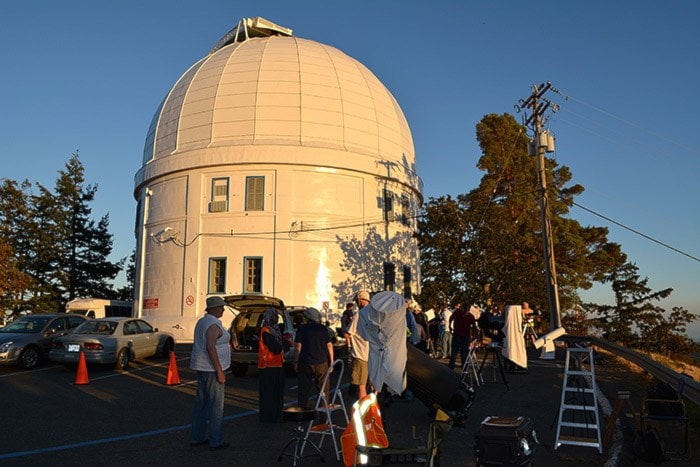Rain threatens to douse the top of Little Saanich Mountain. Heavy clouds drift below it and allow only glimpses of theGreater Victoria Region, Saanich Inlet and the Juan de Fuca Strait.
Notwithstanding the fact that it is daylight, it would be a miserable day for stargazing. Yet it is easy to see why theGovernment of Canada opened the Plaskett Telescope on the top of this mountain almost a century ago.
It is closed on this rainy March afternoon, but impressive nonetheless. Across from it lies the Centre of the Universe, a not-for-profit observatory that features a planetarium, displays and other activities.
On April 29, Little Saanich Mountain will be a centre of activity as the Royal Astronomical Society of Canada (RASC) Victoriahosts the first of its 20 Summer Star Parties as part of Astronomy Day, a series of displays and lectures hosted at the RoyalMuseum of B.C.
It is hard to say how many people will venture up Little Saanich Mountain to take part in the Summer Star Party, but it will bebusy, predicts Ken Mallory, who handles outreach for the society.
"We have had 190 people up on a cloudy night," he said.
Figures like these speak to the popularity of the Greater Victoria region as a hub for amateur astronomers, says Mallory.
The roots of the Royal Astronomical Society of Canada reach to the early 20th century and the Victoria chapter founded in1914 is among the largest across Canada, with a membership of more than 200, exceeding Vancouver's.
"Per capita, we have more astronomers and amateur astronomers here than anywhere else in Canada," says Mallory. "A lotof people are interested in looking up these days. It is a really good hobby."
Recent developments provide more than a few reasons for people to look to the skies.
"We are really reaching out to the inner and outer planets [in the solar system] to see what's going on," he says. "We arediscovering new exo-planets all the time with the Hubble Space Telescope. The James Webb Telescope is going to go up in2018. It is just a marvelous time for watching the skies. It is just incredible the amount of information and stuff that is outthere."
Some credit for the local popularity surely belongs to the local RASC outlet in serving as a focal point for local astronomersand a public resource through events such as the Summer Star Parties and Astronomy Day, a monthly society meetingfeaturing speakers, a free weekly drop-in session for the public held every Monday at Fairfield Community Centre, andschool outreach sessions. Membership in the society does not require a telescope or any prior knowledge of astronomy.
Mallory says the club attracts a wide range of people. They include a lot of retired people like himself, but also students,teachers and professors. A self-described blue-collar worker, Mallory has always had an interest in science, readingveraciously, and he still remembers watching the moon landings when he was eight years old.
"That sort of piqued my interest," he says. Another formative event was seeing the pictures that the Hubble Space Telescopesnapped. "And now that I have hit retirement age, I joined this club five years ago and watched the transit of Venus," hesays. "That really got my attention."
Mallory and his society colleagues are now trying to get the attention of the public when it comes to light pollution. "We doa night-sky survey where we actually go and measure ambient light [available light] in the sky, anywhere from Colwood andLangford right to downtown Victoria." The society also educates the public and municipal politicians about the effects ofdifferent types of lighting including street lighting.
The issue of light pollution is first of all a public health issue, he says. "Melatonin is a very important [hormone]," he says."The more light you have, the less Melatonin you get and Melatonin is good for sleep and various physical process," hesays.Light pollution also harms animals such as migratory birds. Finally, light pollution denies people a cultural andaesthetic experience.
"In the old days, older people used to be look at the constellations and be able to figure out where they are," says Mallory."They used to know all the stories about all the constellations...we are just losing that aspect of our lives. It is part of ourculture that we are losing."
The RASC is part of Victoria's larger astronomy community that also includes the Friends of the Dominion Observatory,which has dedicated itself to showing community support for the observatory and to revitalize its public programing, andthe Centre of the Universe observatory. Both groups openly support each other with overlap in membership.
Astronomy at its highest level appears daunting, a domain of complex figures and theories, yet these groups including theRASC help make it accessible, bringing it down to earth in a manner of speaking.
"I really love showing people things through the telescope what they don't get to see [otherwise]," says Mallory.
As for making any discoveries themselves, Mallory says society members are realistic. "We understand we will probablynever see anything new or discover anything," he says. "We just want to discover what is out there and see for yourself."
